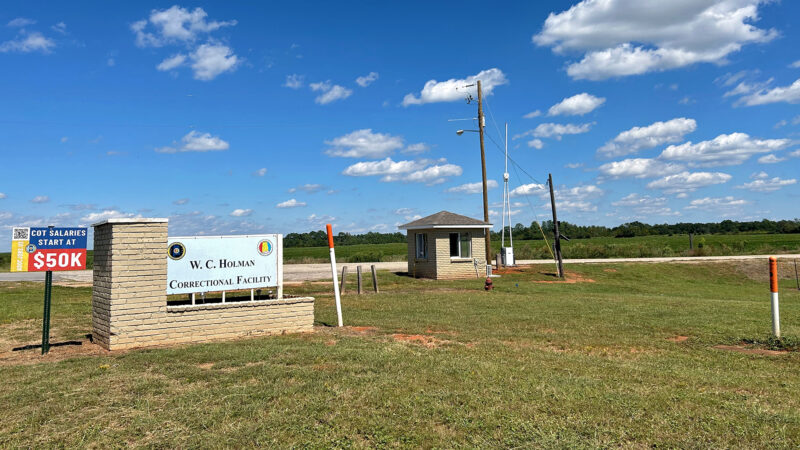Alabama’s 2nd nitrogen gas execution raises questions about method’s future use
W.C. Holman Correctional Facility in Atmore, Alabama, shown here on Sept. 27, 2024, houses the state's men's death row.
Before Alan Miller became the nation’s second-ever person to be executed by nitrogen gas, men living on Alabama’s main death row met to discuss how to stay calm.
That’s according to Esther Brown, the executive director of Project Hope to Abolish the Death Penalty, a group led by incarcerated organizers. Brown’s phone rings every day with calls from people who are imprisoned and sentenced to death.
She said their mood was “very upset, very uptight,” as Alabama readied to use the novel method to put Miller to death — while keeping on pace toward the state’s busiest year for executions since 2011. The Yellowhammer State is set to lead the nation in executions this year, data from the Death Penalty Information Center show.
“Of course, we’re not doing well,” Brown said. “You know, it’s just — incomprehensible.”
Alabama followed through on its plans to execute Miller on the evening of Sept. 26, in a move that stoked outrage and grief among death penalty opponents. It also raised questions about the possible future of the controversial execution method in the Gulf South, while underscoring Alabama’s increasingly atypical use of capital punishment.
Alabama remains the only state to have tested out the nitrogen gas method, but Mississippi, Louisiana and Oklahoma have legalized its use, according to reports.
As Alabama sets this new course for execution methods, William Berry, a law professor and associate dean at the University of Mississippi who often writes about capital punishment, said its eyewitness accounts show the nitrogen gas executions are “way more draconian and brutal” than imagined.
“It seems much more like the same kind of problems you had with electrocution, in terms of this brutality and unintended consequences,” he said. “I wonder the extent to which this will really catch fire and states will start doing this regularly, or not.”
Berry said nitrogen gas executions came into play in response to the availability of and challenges to drugs used for lethal injections. He added that other scholars have written that injection protocols were developed in part because of unpleasant effects — such as smells of burning flesh — related to the electric chair.
In January, Alabama’s attorney general touted nitrogen gas, saying that its “proven method offers a blueprint for other states.” He reaffirmed his stance in a statement after Miller’s execution. His staff didn’t fulfill a recent interview request.
“Tonight, despite misinformation campaigns by political activists, out-of-state lawyers and biased media, the State proved once again that nitrogen hypoxia is both humane and effective,” Marshall’s statement said that night.
“Miller’s execution went as expected and without incident.”
Method likely ‘dead in the water’

But Rev. Jeff Hood, an activist and spiritual advisor to people on death row in several states, said he thinks the method is likely “dead in the water,” and feels unlikely to become commonplace elsewhere.
He noted similarities in witness accounts between the second nitrogen gas execution and the first — of Kenny Smith in January — which he witnessed personally. Witnesses to the first nitrogen execution described a protracted process in which Smith shook and writhed.
“I could hear people in the witness room saying, ‘God, stop, stop, please stop,’” Hood said. “It was horrible.”
Condemnation arrived from all corners of the world, including a U.N. panel, which said it “amounted to torture.” In the American Medical Association’s journal, JAMA, doctors from the University of California San Francisco’s Hypoxia Research Laboratory said hypoxia, meaning low oxygen levels, has inconsistent and “frequently distressing effects” on people, such as “a feeling of suffocation,” and that extreme hypoxia isn’t well-studied in humans because it causes such stress.
Accounts of Kenny Smith’s execution were “proof of the inhumanity of the nitrogen hypoxia method,” they wrote.
Accounts from media witnesses to the second nitrogen gas execution last month described Miller appearing to struggle against his restraints and gasp for air before dying. Miller, whose death sentence pertained to the shooting of three people, took several minutes to be pronounced dead.
Alabama has a third gas nitrogen execution, of Carey Dale Grayson, set for Nov. 21. That case is undergoing court challenges related to the method.
‘Trending downward’

Related issues in the region have drawn national attention this year, starting when Smith was executed in January and Louisiana then legalized nitrogen gas executions, prompting outcry from groups including Jewish advocates.
It isn’t yet clear how the outcome of the two nitrogen gas executions in Alabama impacted attitudes toward the method in Mississippi. A spokesperson for its attorney general and the sponsor of a related bill, who is no longer in the legislature, didn’t immediately respond to emailed requests for comment.
In Louisiana, where nitrogen gas executions were legalized earlier this year, Attorney General Liz Murrill said in a statement that she supported the bill that expanded the state’s execution methods. She said she would defend the law, adding that “victims of crime and their families deserve justice.”
House Rep. Nicholas Muscarello introduced the bill that ultimately legalized nitrogen gas executions. He said in an interview he had “no opinion” in response to some of the criticisms advocates have raised of the method.
“At the end of the day, my thought is if it’s deemed constitutional and it’s been challenged and upheld by the court, then that’s the method that should be an alternative to the lethal injection,” he said.
Questions about methods to put someone to death also have emerged amid a recent and unusual surge in executions. That’s likely due to a “confluence” of factors, including a perceived backlog, priorities of a small group of politicians and the dynamics of the U.S. Supreme Court, according to Berry, of the University of Mississippi.
But overall, he says the use of the death penalty remains rare.
“I think this is trending downward and slowly, I think, disappearing,” he added. “We’ll see if nitrogen hypoxia is something that actually accelerates that decline, or something that prolongs it.”
‘Forever etched in the memory’

Miller’s execution mobilized death penalty opponents to events across Alabama.
As the execution approached, rain-soaked advocates gathered on the Capitol steps in Montgomery, where 21-year-old TJ Riggs made an emotional speech calling on state leadership to end what he called the “barbaric suffocation” of Alabamians.
“How many more dates must be forever etched in the memory of our community, and of the men on the row?” Riggs, who is the death penalty abolition coordinator for Amnesty International in Alabama, said.
The following evening, a small group of about nine people gathered a little down the road from the William C. Holman Correctional Center in Atmore — where Smith was executed — to protest and hold a vigil. The sun set over a gravel-and-grass parking lot as they held up signs or raised hands in prayer.
Some, like social worker Tish Warr, openly wept. Warr said her mom was once incarcerated, and the family friend who walked her down the aisle at her wedding once had been on Texas death row but was re-sentenced and released.
“I believe that every person, every human inside of our Department of Corrections has a family and has an impact they have made on the world,” she told a reporter. “And I believe that every single person is capable of change.”
The prison is situated down a curving roadway, where it couldn’t easily be seen from where protesters gathered.
That week, Brown said previously, men at the prison had gathered together for their typical traditions the week of an execution. Those include sharing memories and prayers for the person who is about to die, whom they generally have lived with for years.
Miller was known as a quiet man who enjoyed watching television. He’d become closer to Smith, the previous person executed by nitrogen gas after both survived an earlier execution attempt by lethal injection.
Brown said some wear the white clothes they typically don for visitation. And later bang on doors as the person being executed is led to his death.
“They bang on it and [are] kicking it in the hope that the man can hear that, can hear them,” she said. “And as a way of saying, ‘We’re with you.'”
This story was produced by the Gulf States Newsroom, a collaboration between Mississippi Public Broadcasting, WBHM in Alabama, WWNO and WRKF in Louisiana and NPR.
Vance refuses to set red lines over bigotry at Turning Point USA’s convention
Vice President JD Vance acknowledged the controversies that dominated the Turning Point conference, but he did not define any boundaries for the conservative movement besides patriotism.
CBS News chief Bari Weiss pulls ’60 Minutes’ story, sparking outcry
CBS News Editor-in-Chief Bari Weiss pulled a 60 Minutes segment on allegations of abuses at an El Salvador detention center where the Trump administration sent hundreds of Venezuelan migrants.
Lawmakers threaten Attorney General Bondi with contempt over incomplete Epstein files
The Justice Department is defending its initial release of documents related to sex offender Jeffrey Epstein, saying lawyers are still going through them to ensure victims are protected.
How a power outage in Colorado caused U.S. official time be 4.8 microseconds off
Officials said the error is likely be too minute for the general public to clock it, but it could affect applications such as critical infrastructure, telecommunications and GPS signals.
Scientists say they have discovered 20 new species deep in the Pacific Ocean
Researchers retrieved reef monitoring devices that had been placed in deep coral reefs in Guam. The devices were placed up to 330 feet below the surface.
Shopping for pricy ACA health plans? Some cheaper options come with trade-offs
Without a fix from Congress, costs for many people who buy health care on the Affordable Care Act marketplace have gone up. Here's what's to know about cheaper choices — and pitfalls to be aware of.








